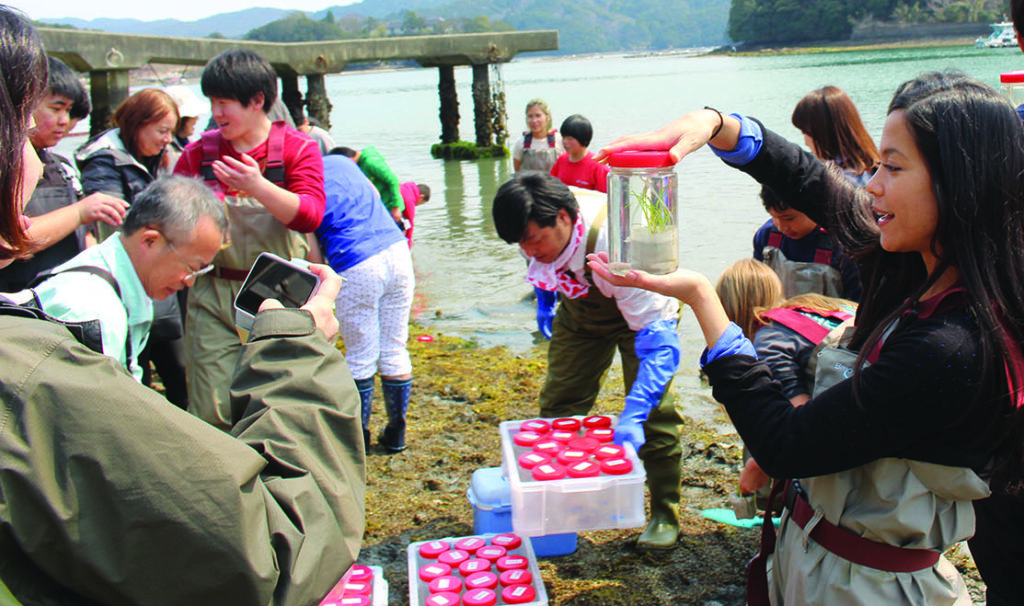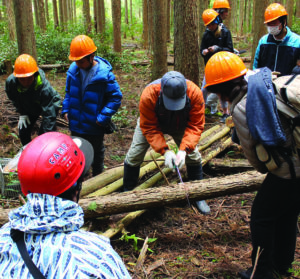Broadening Student Perspectives Through Collaborative Research in Environmental Science in Japan and Hawai‘i
Island communities have traditionally been models of sustainability. Their limited area and isolation ensured the development of environmental practices that maximized resource protection for future generations. However, island ecosystems face increasing pressure from expanding human populations, invasive species and climate change. The modern global economy results in many island communities becoming increasingly more dependent on outside resources, including the importation of food to sustain populations. Yet, as the planet faces increasing concerns over sustainability, islands may provide some of our best insights into how to overcome difficulties and to identify solutions to resource management.

The Kai Yama Program was designed to address some of the shared challenges that island communities and ecosystems face. It is a collaborative partnership funded by the Japan U.S. Friendship Commission and developed by faculty from Kapi‘olani Community College (KCC) and Kansai University in Japan that brings together undergraduate students from both institutions to communicate experiences and to seek solutions to environmental issues, using online tools and site visits.
“While the scale of the islands of Japan is much greater than the Hawaiian Islands, the two communities have much to share,” said Wendy Kuntz, Kai Yama faculty director and associate professor of biology and ecology at KCC. “The project name was chosen from the Native Hawaiian word for ocean, Kai, and the Japanese word for mountain, Yama.”
Over the calendar-year program, a cohort of faculty and students from both countries come together to research environmental science issues. Online technologies are implemented to build relationships, identify commonalities and generate new solutions to ecological issues. Two week-long country site visits allow the students from Japan and Hawai‘i to work to generate positive change in local communities and to practice environmental science as a team. Students meet with community members to learn more about local environmental challenges, investigate using environmental science methodology and collaborate to identify solutions. The Kai Yama project embarked with the first cohort in 2016, had a second cohort in 2017 and are now in the midst of a third cohort for 2019.
This research experience has broadened my horizon about future career pathways within the field of environmental conservation. Working in the Kai Yama Program with students from different academic and cultural backgrounds has helped me develop a better understanding of the similar, yet very different environmental problems in other countries and societies. The amazing work that we were able to accomplish with these students in a short amount of time has inspired me to think beyond Hawai’i and to look at conservation at a global scale. This cross-cultural environmental collaboration between students has created an avenue for learning within the environmental field that has never been explored to this extent before.
– Alex Awo, 2016 Kai Yama Participant
“The Kai Yama program opens up opportunities for these undergraduate students to explore new academic pathways and identify options for majors or careers,” said Kelli Goya, KCC pathways coordinator. “The strong science emphasis of the Kai Yama program, trains young researchers on not only skills but on how to communicate and problem-solve on a global stage.”
The Kapi‘olani Community College students in the Kai Yama program are first and second year undergraduate students with an interest in environmental science or sustainability fields. Since 2016, nineteen students have participated over the three cohorts. Prior to being selected for the Kai Yama program most of these students had not worked with international peers or travelled outside of the U.S.; two-thirds did not have a passport. Most had not considered study abroad, either due to the perceived time commitment, cost or family obligations.
The knowledge I have gained through the activities in the Kai Yama experience has opened my eyes to new possibilities. By building friendships and collaborating with the Kansai students, we were able to tackle the huge task of learning and teaching others about the importance of saving our environments, locally and abroad. Through this life-changing experience, I had the opportunity to learn and work with peers from a different country to gain a deeper understanding of issues and solutions to a global problem. I also learned the importance and effectiveness of learning and working with others no matter who you are or where you’re from.
– Kimberly Kahaleua, 2016 Kai Yama Participant
The Kai Yama program is unique in that it incorporates both online learning and teamwork and two field research experiences, one in each country. While the program structure was developed to fit the needs of students, especially the early career STEM students at Kapi‘olani Community College, it has converged on an emerging pedagogy in international education called Collaborative Online International Learning (COIL). The Kai Yama program has now been put forward as a model of COIL in action and has been shared at national conferences.

Each cohort has researched a different aspect of an environmental science issue, one that impacts both island communities. In 2016, the students studied invasive species and their impacts on local communities. During the Hawai‘i site visit, they worked with the local community organization, Mālama Maunalua, to remove over 675 pounds of invasive algae species from Maunalua Bay on O‘ahu and to quantify the effectiveness of the management technique. Both before and after removal, students used ecological techniques to monitor the percent cover for both native and invasive algae species. In Japan, they traveled to the mountain village of Kuta, where they interviewed local residents and studied the impacts of land conversion to forest plantations.
The 2017 cohort examined practices of traditional land management in both Japan and Hawai‘i and investigated the potential for these methods to inform modern sustainability. In Japan, the students researched watershed changes after the construction of a river dam. Together the students learned about the traditional land management practice of satoyama (mixed landscape) and compared it with the traditional Hawaiian land management system of the ahupua‘a. During the 2017 Hawai‘i site visit, the Kai Yama students traveled together to Moloka‘i Island and worked with the local community restoring Keawanui Fishpond. The 2019 cohort is examining food sustainability, both in the past and present, as uniquely important island issues.
In the beginning, I was hesitant about joining Kai Yama. I personally lacked confidence in my communication and speaking skills, but each day in Japan, I had the chance to practice explaining English words and environmental concepts. This program has allowed me to become more comfortable in speaking and explaining scientific concepts more clearly.
– Jayson Gose, 2017 Kai Yama Participant

